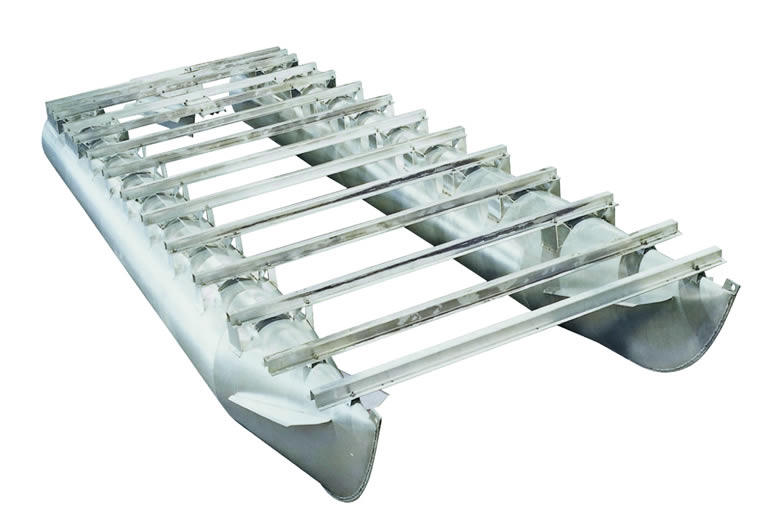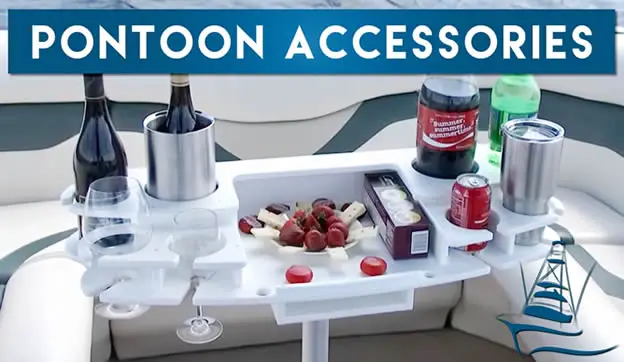Pontoon boats are very popular recreational vessels used largely on calm inland waters. Their unique flat bottom hull offers plenty of deck space but it is their sturdy pontoon tubes that help to keep them afloat. Pontoon tubes are also called pontoon logs, pontoon floats, pontoons, and toons. These terms refer to the same thing and often used interchangeably.
The pontoon floats are a very recognizable part of the boat and you will have seen standard pontoon boats with two pontoon logs and others with three (a tritoon) but have you ever wondered what is in a pontoon tube?
Although there are foamed-filled tubes, most pontoon tubes are hollow. Some pontoons are filled with air to help strengthen the inner walls of the tube and to also check for leaks. Many modern pontoon tubes are hollow and chambered, being divided inside into sections for safety reasons.
Contents
Let’s take a look inside a pontoon float
Most pontoon boat pontoon tubes are completely hollow. However, this is not to make them more buoyant.
The buoyancy of a pontoon tube lies in its ability to displace water. I will cover how this works later in this article. For now just know that a pontoon tube is usually hollow. Many of these hollow tubes are chambered for reasons I will cover later. There are foam-filled pontoon tubes as well though these are much less common.
Let’s look at the different types of pontoon tube to see what is inside them.
The three types of pontoon log and how they work
The three types of pontoon tube/pontoon log/pontoon float/pontoon/toon are:
- Air-filled pontoons.
- Foam-filled pontoons.
- Hollow, chambered pontoons.
I will now quickly cover exactly what each of these floats is, how it is constructed and the main benefits it offers.
Air filled tubes
As I already mentioned most pontoon tubes are hollow. Some are left empty while others are filled with air. Why is this?
Well believe it or not filling a pontoon tube with air, or even nitrogen or other lighter than air gases, will have zero affect on its buoyancy. Filling a pontoon tube with air does not make the boat float better either.
So why do they do it?
There are 2 main reasons for filling a hollow pontoon tube with air:
- To strengthen the inner walls of the tube.
- To check the tube for leaks.
Although many pontoon boat owners will fill their hollow pontoon tubes with air to help strength the inner walls of the tube this is not the main reason for adding air to them.
Manufacturers will fill a pontoon tube with air in the factory as a final check for leaks. If air escapes from the tube then that means water will enter the tube when it is in the water.
This air should stay in the pontoon tube until the owner of the boat decides to open the drain plug when he/she wishes to check the tube has not taken on any water.
Opening a drain plug on a pontoon tube and hearing air escape is a very good sign as it shows there are no leaks in the pontoon. Obviously this can only be done once, unless the boat owner replaces the air in the tube. This is more often than not a bad idea.
It is all too easy to damage a pontoon tube by over-pressurizing it. Re-filling a tube with air should be done with extreme caution, forethought and the appropriate equipment if you wish to avoid damaging your tubes or having an accident.
If you have air-filled tubes on your pontoon boat and wish to refill them after checking the tubes for water-intake be sure to read this article first, as you can cause damage to them by not doing it right.
As air does not add any weight to the pontoon tube, filling it with air has not negative effect on the pontoon’s ability to float. I will cover how weight effects a pontoon tube’s buoyancy later i accordance with the principle of flotation.
Foam-filled tubes
Some pontoon boats have pontoon tubes that are filled with foam. Again, this has nothing to do with increasing the buoyancy of the pontoon tube when the boat is in use.
Just as filling a pontoon tube with air, or lighter than air gases, has zero effect on its buoyancy, adding foam to the inside of a pontoon tube has no effect on its buoyancy either. In fact it actually makes the pontoon heavier and less buoyant! (You will understand why later).
So why fill them with foam?
Well, foam helps the pontoon tube float when it is submerged in water. “Wait … I thought you said foam didn’t help the tube float any better?” you may be thinking, and rightly so.
Let me explain what I mean.
Foam inside a tube, or a boat for that matter, does not make the tube, or boat, any more buoyant. Flotation occurs due to water displacement. The principle of flotation tells us how well an object floats in the water above the water line. (I promise to explain how this works fully later in this article).
Having foam on the inside of a pontoon tube only becomes an advantage when the pontoon tube sinks below the waterline i.e. when the pontoon boat starts to sink. Foam will help keep the pontoon tube from totally sinking to the bottom of the lake.
A pontoon tube that is filled with foam will not sink to the bottom and will help the boat stay afloat just under the water line for easier retrieval should the pontoon boat sink.
Having said that, most manufacturers that actually produce foam-filled tubes merely use them because it saves them money.
Not only are foam-filled pontoons cheaper for the manufacturer but it also allows manufacturers to use inferior quality (i.e. thinner) gauge material for the tube construction because the foam gives the tube a certain amount of inner wall protection.
Although there are always exceptions to every rule, my pontoon tube rule states that … foam-filled pontoons are inferior to hollow and chambered pontoons.
Chambered tubes
Chambered tubes are basically hollow tubes that have been divided into sections. Instead of one long hollow tube, the tube has different compartments, each separated from the other.
Why chamber a pontoon tube?
Well, its about safety.
When a hollow tube develops a leak it will start to let water into the tube. When this happens the tube will become heavier and thus lose buoyancy (this will make more sense later).
When a pontoon tube loses buoyancy it can have very bad affect on the boat, leading to outright sinking or causing the pontoon boat to take a nosedive.
Even the smallest hole or crack in a pontoon, which is allowing water to get into the tube, is enough to fill the entire pontoon tube over time, thus badly affecting the boat’s buoyancy and ability to perform at its optimal level. To counteract this problem manufacturers developed chambered pontoons.
By dividing the interior of the pontoon into sections, a hole or crack in the tubes will have less affect on the pontoon’s buoyancy because the water intake will be limited to a small section and not the entire tube.
Chambering may not have saved the Titanic but it is a sound design feature than can save your pontoon boat.
How pontoon tubes keep the boat afloat
So what’s all this about buoyancy and the principle flotation and why does it effect how pontoon boat pontoon tubes are made?
I have already covered why pontoon boats float in a previous article but it is necessary to quickly cover some of the concepts visited in that post here. By revisiting the principle of flotation you will better understand why pontoon tubes are made the way they are and why they don’t need to be filled with anything.
All objects, including the pontoon tubes that hold up a pontoon boat, are subject the principle of flotation. What is this principle?
The principle of flotation was brought to us by in Archimedes back in the third century.
It states that:
Any object will float if it displaces the same weight in water that is equal to, or greater than, its own weight.
Water displacement simply refers to the water that is moved to make room for the object; when an object is placed in a fluid, such as water, it moves water out of the way to make room for the part of the object that sits in the water.
So, in order for a pontoon tube to float it must displace (move) enough water, so that the water is displaces (moves) weighs the same as, or more than, the weight of the pontoon tube.
It is the shape and weight of the pontoon tube that helps keep it afloat. This is because the shape and weight ensures the pontoon, when it sits in the water, moves more water (in weight) than its own weight.
Obviously this means making a pontoon tube as light as possible is an advantage. The heavier the pontoon tube is, the closer it will be to the weight of the water is has displaced and the less buoyant it will be.
The above explanation should have made 3 major points in this article easier to understand namely:
- Putting air or lighter than air gases into a hollow pontoon tube will not make it float better. Therefore, a pontoon tube can be hollow.
- Filling a pontoon tube with foam (or anything else) actually makes it heavier and therefore less buoyant because it is getting closer to the weight of the water it is displacing.
- Chambering a pontoon tube helps protect the entire tube from filling up with water and becoming too heavy to float.
Of course there is more to keeping a pontoon boat afloat than just the principle of flotation. We must also consider the law of buoyancy. If you want a deeper explanation of this law and the principle of flotation I suggest you read our article How Do Pontoon Boats Work.
Also be sure to check out our 55 top pontoon boat accessories that can turn your boat in a floating fun-filled pleasure palace.
What happens when pontoon logs fail?
If you want to know what can happen when the tubes on a pontoon boat fail, when for example they get damaged and take on water, read the article why do pontoon boats sink.
That article article will outline the dangers of faulty pontoons and the highlight the possible consequences of failing to maintain your boat’s pontoon logs.



